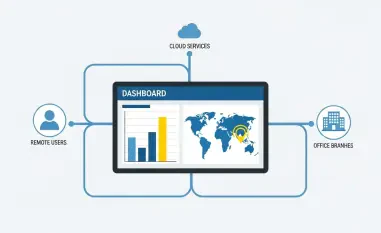The rapid evolution of cloud computing has brought significant benefits for businesses, including enhanced efficiency, security, and reliability. However, this progress has introduced a substantial challenge: a widening gap in cloud computing skills. Many organizations are struggling to manage modern cloud environments effectively due to a lack of expertise. These complexities make it vital to explore possible solutions to mitigate these challenges. One emerging solution is Network as a Service (NaaS), which promises to alleviate some of the burdens associated with cloud management and allows businesses to focus more on strategic initiatives.
The Growing Challenges in Cloud Management
As businesses increasingly rely on cloud computing, the demand for skilled IT professionals who can manage these systems has surged. Unfortunately, many IT teams find it difficult to keep up with the rapid pace of cloud innovations. This skills gap hampers their ability to train or upskill staff adequately, leading to inefficiencies and potential security risks.
Managing cloud environments requires a deep understanding of various tools, platforms, and security measures. The complexity of cloud technologies exacerbates the issue. Without the necessary expertise, businesses may struggle to fully leverage the advantages of cloud architecture, impacting their overall performance and competitiveness. This is further complicated by the fact that cloud computing is continuously evolving, and what once was an effective strategy can quickly become outdated.
Businesses must recognize that this skills gap is not merely a technical issue but a strategic one. The inability to manage cloud environments efficiently can lead to significant downtime, compromised data security, and inefficient use of resources. This, in turn, affects a company’s bottom line and its ability to stay competitive in a fast-paced market. Therefore, finding solutions to bridge this gap is imperative for long-term success.
The Financial Impact of the Digital Skills Gap
The digital skills gap has substantial financial implications for economies worldwide. In the United States alone, it is projected to cost the economy up to US$ 975 billion in GDP by 2028. This staggering figure highlights the urgency for businesses to address the skills shortage and seek effective solutions. The cost is not only measured in GDP losses but also in missed opportunities for innovation and growth.
Similarly, the situation is concerning in Asia, where nearly 60% of organizations face skills shortages in the digital domain. A Deloitte survey reveals that cloud computing is the most in-demand skill among IT leaders, yet 80% of them cite a lack of cloud expertise as a significant obstacle. These statistics underscore the global nature of the problem and the need for innovative approaches to bridge the gap.
The financial impact extends beyond the immediate costs of hiring and training new staff. Businesses must also consider the opportunity costs associated with the skills gap. With IT teams bogged down by the complexities of cloud management, they have less time and resources to dedicate to strategic initiatives and customer-focused improvements. This can slow down innovation and hinder a company’s ability to respond to market changes swiftly.
The Complexity of Cross-Training IT Teams
Many companies attempt to bridge the skills gap by cross-training their IT teams. However, the sheer complexity of cloud-related skills makes this a daunting task. Mastery in areas such as Python scripting, WAN engineering, and data center security requires extensive training and hands-on experience, which cannot be acquired quickly. This process is cumbersome and often disrupts the workflow and efficiency of IT teams.
Moreover, the rapid pace of cloud innovation means that IT professionals must continuously update their knowledge and skills. This constant need for learning and adaptation places additional strain on IT teams, making it challenging to keep up with the latest developments and best practices in cloud management. The pressure to stay current can lead to burnout and high turnover rates, further exacerbating the skills gap issue.
The complexity doesn’t end with acquiring the knowledge. Implementing what IT teams learn often involves significant changes to existing systems and processes, which can be disruptive. Additionally, not every IT professional can easily apply newly learned skills, leading to inefficiencies and errors. Companies must, therefore, consider more integrated and sustainable solutions to the skills gap beyond just cross-training.
The Rise of Multi-Cloud and Direct Connectivity
The adoption of multi-cloud strategies and direct cloud connectivity is becoming increasingly common among businesses. More than 90% of companies worldwide use services from major cloud providers like AWS, Google Cloud, and Microsoft Azure. These strategies offer enhanced security, reliability, and bandwidth, but they also require specialized knowledge of each provider’s tools and terminology. The intricacies involved in managing multi-cloud environments add to the challenge faced by IT teams.
Effective cloud monitoring is crucial for maintaining performance, and it demands familiarity with specific monitoring tools such as Amazon CloudWatch, Google’s Network Intelligence Center, and Azure Monitor. The need for such specialized skills adds to the burden on IT teams, further highlighting the importance of finding solutions to the skills gap. The complexity of managing these multi-cloud environments often detracts from core business activities, necessitating alternative strategies for effective cloud management.
Additionally, direct cloud connectivity requires a detailed understanding of networking principles and the nuances of each cloud provider’s infrastructure. Any lapse in managing these connections can lead to significant performance issues or security vulnerabilities. Businesses must recognize the importance of specialized skills in maintaining multi-cloud strategies and direct connectivity to ensure optimal performance and security.
Network as a Service (NaaS) as a Solution
Simplified Network Management
Network as a Service (NaaS) offers a promising solution to the cloud skills gap by simplifying network management. NaaS abstracts away much of the complexity traditionally associated with network setups, allowing IT teams with limited technical expertise to perform network tasks efficiently through a user-friendly interface. This enables businesses to manage their networks without highly specialized knowledge, easing the burden on their IT teams.
This simplification enables businesses to manage their networks without the need for highly specialized knowledge. By reducing the technical demands on IT teams, NaaS allows them to focus on more strategic initiatives, improving overall productivity and effectiveness. By handling the complexities, NaaS allows businesses to focus on what they do best, driving innovation and delivering value to their customers.
NaaS providers often offer additional services such as automated updates and maintenance, further reducing the workload on internal IT teams. This allows businesses to stay up-to-date with the latest advancements in cloud technology without dedicating significant resources to continuous learning and adaptation. Simplified network management through NaaS can be a game-changer for businesses struggling to keep up with the rapid pace of cloud innovation.
Scalability and Flexibility
One of the key advantages of NaaS is its scalability and flexibility. NaaS solutions can adapt to business growth without requiring in-depth network management knowledge. Automated scaling in response to traffic load mitigates the risk of manual provisioning errors, ensuring that the network can handle increased demand seamlessly. This flexibility allows businesses to scale their networks up or down as needed, providing the agility required to stay competitive in a dynamic market.
This flexibility is particularly valuable for businesses experiencing rapid growth or fluctuating traffic patterns. With the capability to adjust network resources in real-time, companies can respond swiftly to changing demands without compromising performance. This adaptability not only supports business continuity but also enhances customer satisfaction by ensuring seamless service delivery.
Moreover, NaaS allows businesses to experiment with different configurations and strategies without the risk of significant disruption. By leveraging NaaS, companies can test new approaches and scale resources as needed, enabling them to innovate faster and stay ahead of the competition. The ability to promptly adjust resources to meet business needs provides a significant strategic advantage.
Reduced Reliance on In-House Expertise
By outsourcing network functions to NaaS providers, companies can significantly reduce their reliance on highly specialized network engineers. NaaS providers handle essential functions such as load balancing, routing, and ensuring network security, freeing up internal IT teams to focus on other critical areas. This shift not only alleviates the burden on IT teams but also helps businesses optimize their resources.
This shift not only alleviates the burden on IT teams but also helps businesses optimize their resources. With NaaS, companies can leverage external expertise to manage their networks effectively, allowing their internal teams to concentrate on driving innovation and improving customer experiences. This reduced reliance on in-house expertise is particularly beneficial for smaller businesses or those with limited IT budgets.
NaaS providers often have access to the latest technologies and best practices, ensuring that the managed networks are always at the cutting edge. This access to advanced capabilities provides businesses with a level of network performance and security that might be difficult to achieve with in-house resources alone. By relying on NaaS, companies can achieve more with less, maximizing their return on investment.
Enhanced Security
The rapid evolution of cloud computing has delivered immense benefits for businesses, including improved efficiency, security, and reliability. Nonetheless, this progress has given rise to a significant challenge: a growing gap in cloud computing skills. Many organizations find themselves struggling to manage modern cloud environments effectively due to a shortage of expertise. These complexities underscore the importance of identifying solutions to address these challenges.
One promising solution is Network as a Service (NaaS). NaaS aims to relieve some of the burdens associated with cloud management, enabling businesses to redirect their focus towards strategic initiatives. By outsourcing network management to specialized providers, companies can ensure they leverage the best technology without needing in-house expertise. This shift not only optimizes resource allocation but also enhances the ability to adapt to technological advancements rapidly. The adoption of NaaS could be a pivotal move for organizations looking to maximize their cloud investment and improve overall operational efficiency.













